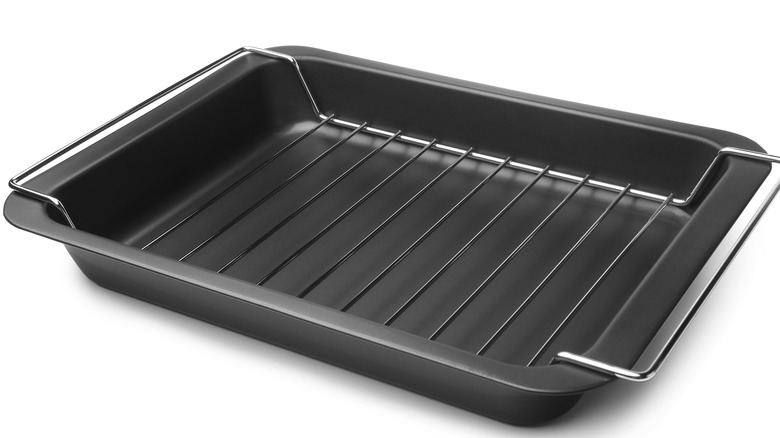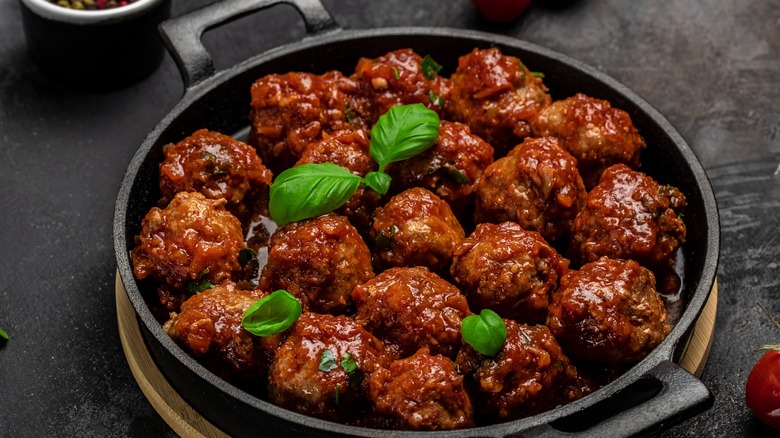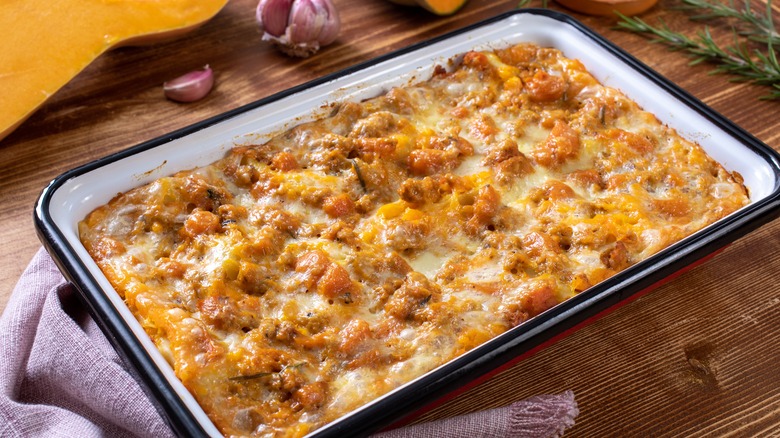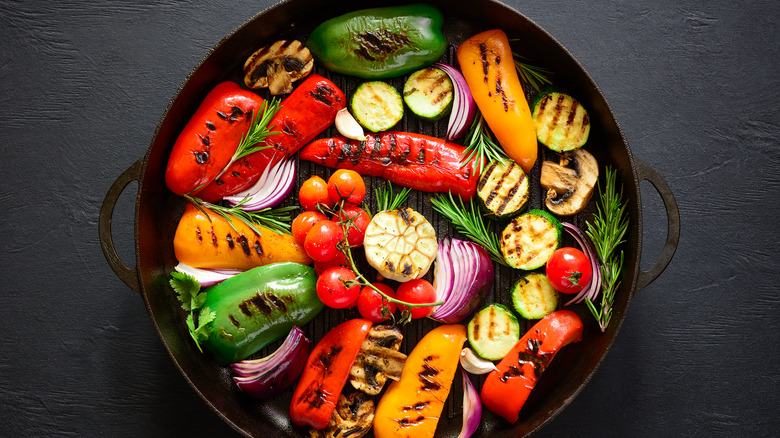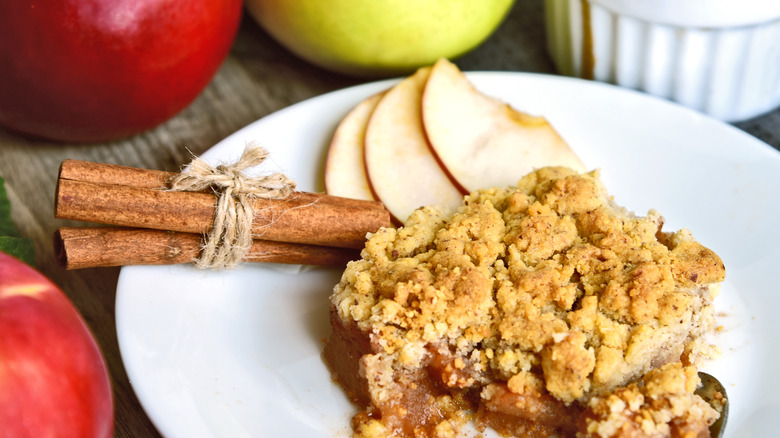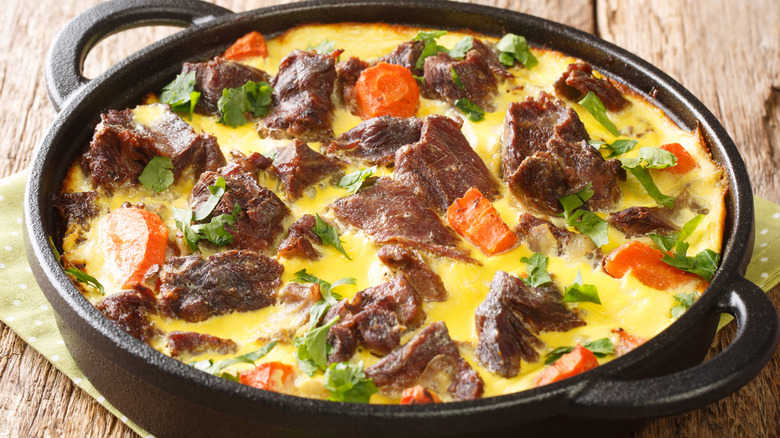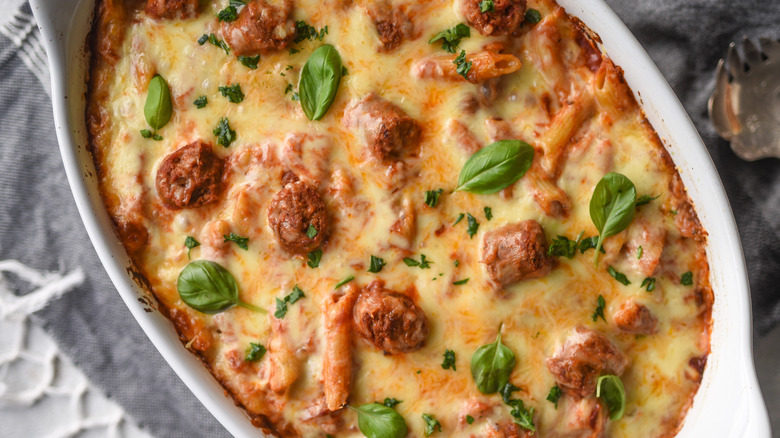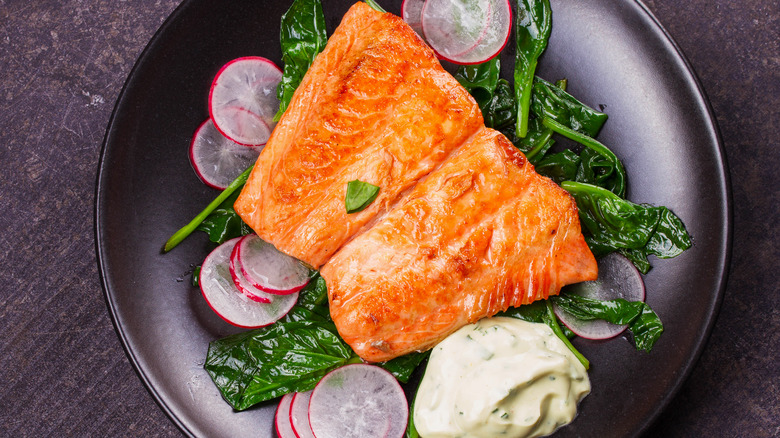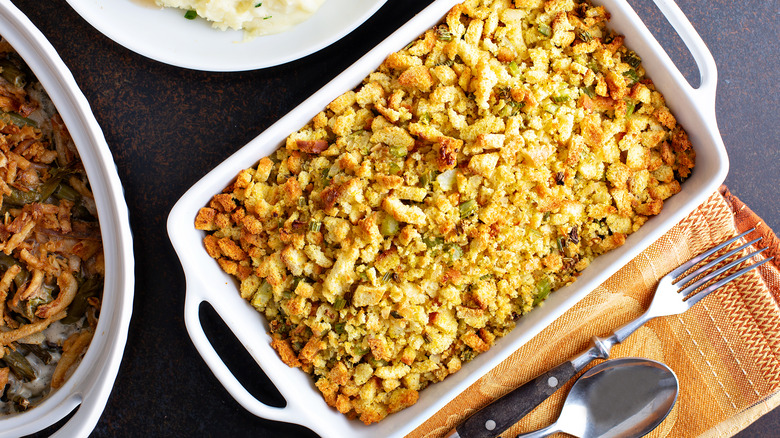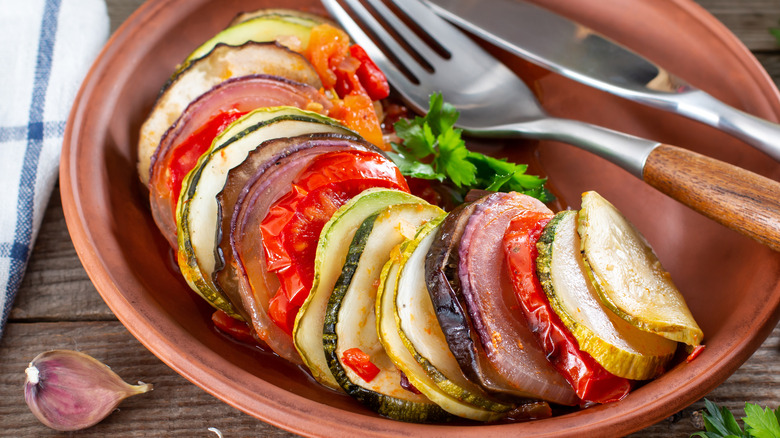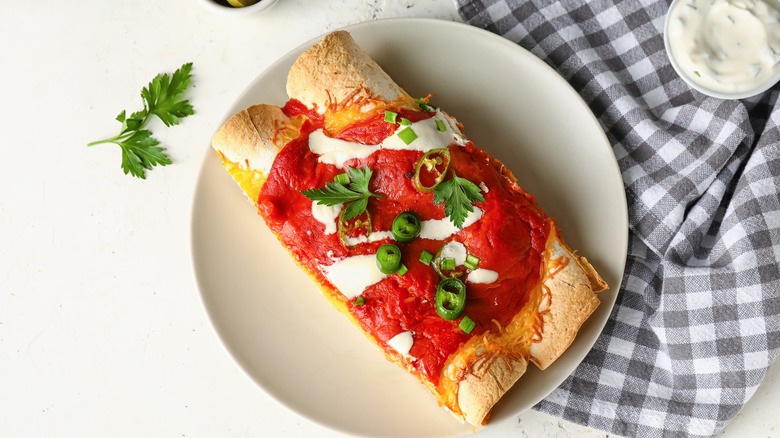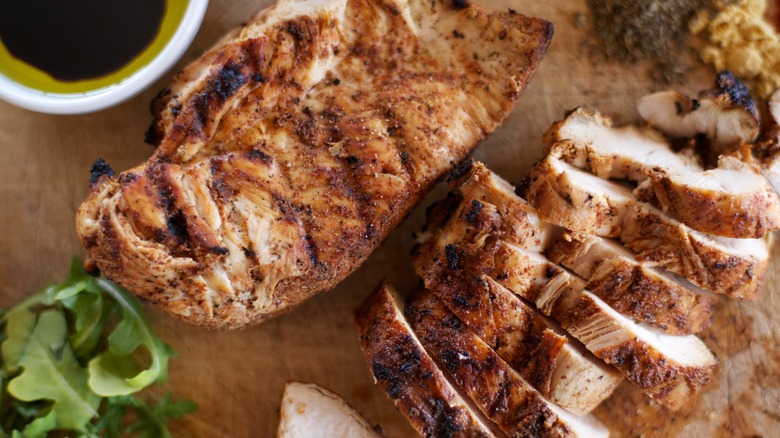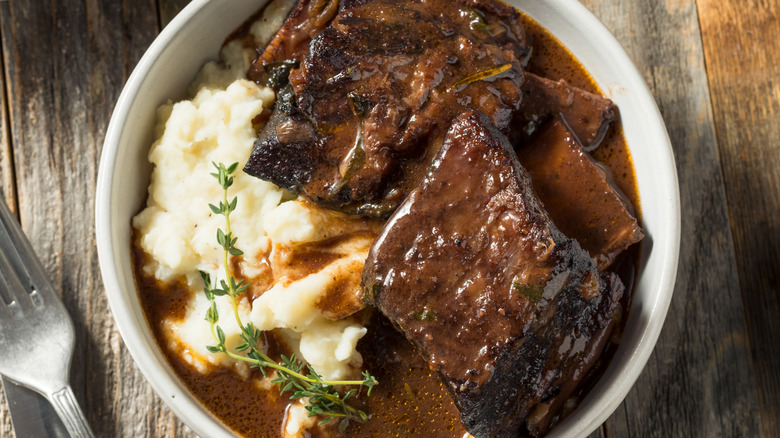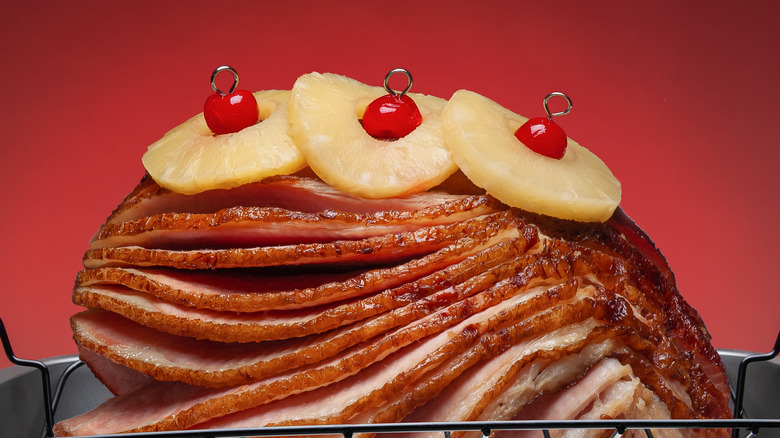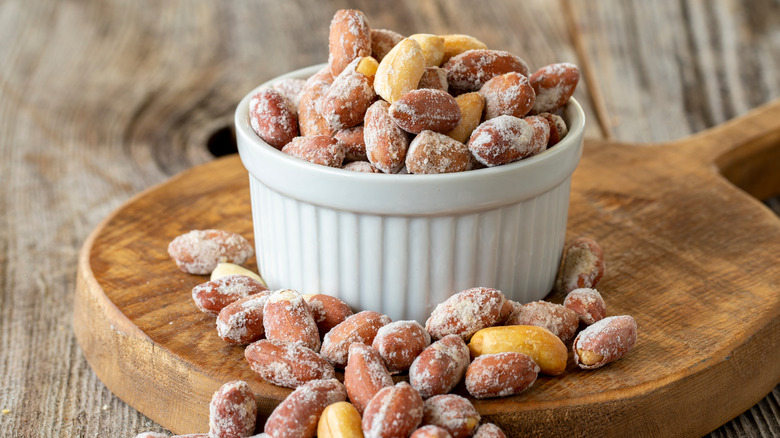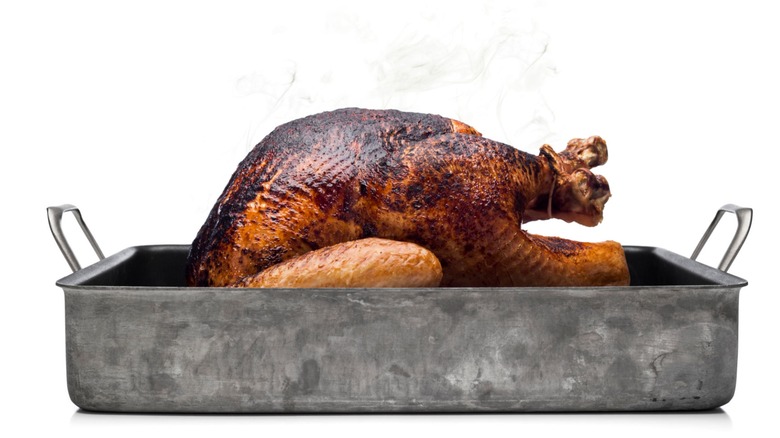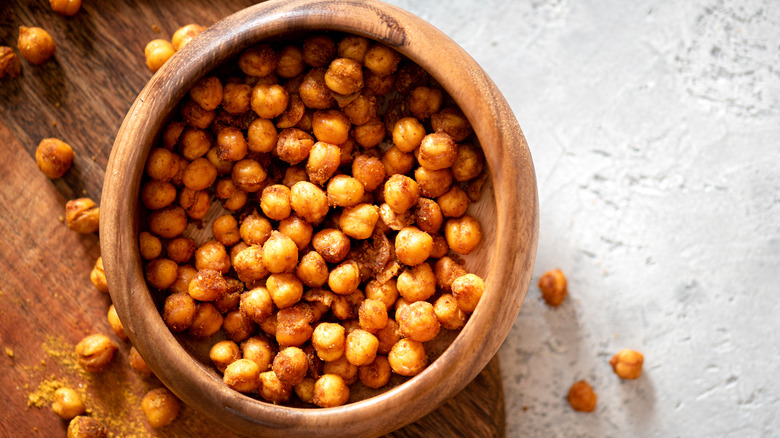The Absolute Best Uses For Your Roasting Pan
Roasting pans are a vital type of cookware for your kitchen — for Thanksgiving and beyond. The roasting pan is the perfect pan for novice and professional cooks alike, regardless if you use it for roasting. Roasting pans can have small to moderately tall walls, which are normally thicker than those of a baking pan. If you are considering purchasing a roasting pan, you should first assess the size and material you can work with. Carrying a hefty ceramic roasting pan may not be practical for your kitchen, while a glass roasting pan is not suitable for broiling. If you plan on entertaining, you might opt for a more upscale pan from Le Creuset or Staub.
You can purchase many accessories to outfit your roasting pan. Xtrema notes that home chefs who use roasting pans for turkey, tenderloin, or ham should invest in a roasting rack to keep the meat from touching the bottom of the pan and allow the air to circulate and cook all sides of the meat. Purchasing an accompanying lid for your roasting pan, Xtrema notes, is optional (since you can use aluminum foil for the same effect) but may make your roasting pan more versatile in trapping steam inside the pan — similar to the mechanics of a Dutch oven. For ease of simplicity, the uses for a roasting pan listed here do not require a lid or a roasting rack, but some recipes would benefit from one or both if you decide to purchase accessories.
Make a batch appetizers
If you're an avid tailgater or game-day chef, you know how stressful it can be to get so many different appetizers in the oven. But with the help of your roasting pan, cooking large batches of appetizers couldn't be easier. One of our favorites to make is a Frito pie with smoked salmorje. It's a step-up from your game-day dip with the addition of savory layers of corn chips, queso fresco, Colby cheese, and cojita cheese. This recipe for Frito pie requires charring the spicy peppers and tomatoes before layering the pie. Luckily, if your roasting pan is safe at upwards of 500 F, you can use the baking pan to char the veggies. After removing the roasted peppers, you can wipe down the roasting pan and layer your chips, chili, cheese, and peppers. Finish the dish by baking for a few minutes until the cheese is melted.
Some of our other favorite tailgate options are BBQ meatballs recipes. Combine the meatball ingredients together in a bowl before placing the balls in the roasting pan. Then, toss the meatballs with BBQ sauce, parmesan cheese, and chives if desired.
Bake a casserole
Casseroles are another creative way to use your roasting pan. The deepness of the baking pan makes using the cookware for deep-dish recipes ideal. Luckily, casseroles come in many different forms that can satisfy any palate, cuisine, or experience. The midwestern tater tot casserole, for example, starts with a layer of bacon, cheese, canned soup, onion, and ground beef. Then, the casserole is sealed with a layer of frozen tater tots. It's uniquely easy and allows you to cook a kid-friendly dinner in less than an hour. If your roasting pan is stove-top safe, you should consider cooking the ground beef and the onions, removing them, and then roasting the bacon in your oven. It's much less work to clean up than using several different cookware pieces!
Lasagna and your roasting pan are a match made in heaven. If you're looking for a non-stick roasting and lasagna pan, we recommend checking out Wilton's 14-inch by 11-inch pan. Its sides are two inches deep, making it the perfect depth for a family-sized casserole. You'll also love that the pan is easy to clean and can go right in your dishwasher.
Roast vegetables
Roasting pans are not exclusive to carnivores. Your roasting pan is an excellent vehicle for perfectly roasted root vegetables, peppers, and tubers. Simply slice and dice your favorite vegetables, coat in a generous layer of oil and seasonings, and roast until you are content with the results. You should plan on using one tablespoon of oil per pound of vegetables when roasting. We also recommend that you avoid setting the oven's heat too high for both the sake of your roasting pan and your veggies.
Sweet, dense veggies (like carrots) should be roasted at lower temperatures than watery vegetables (like zucchini). Along with avoiding putting oily foods under your broiler, glass roasting pans will shatter when exposed to direct, high heat. So, you should use a ceramic, cast iron, or enameled cast iron pan if you plan on roasting your veggies at temperatures higher than what the manufacturer regards as safe. If you want crispier roasted vegetables, try adding a tablespoon of cornstarch per pound of produce.
Bake an cobbler or a fruit crisp
Sweet dreams are made of — roasting pans? Yes, you can use a roasting pan for baking your favorite type of fruit crisp or cobbler. While you can make a fruit crisp in a typical baking dish, the size of the baking dish limits how many apples and streusel you can use. Most fruit crisp recipes bake from 350 to 400 F, so you should be able to use glass, cast iron, or non-stick roasting pans. If you're cooking for a crowd, consult your roasting pan before you worry about making several small desserts in the miscellaneous baking pans you have hanging around your house.
You'll want to layer the fruit and top with a coating of streusel before baking in the oven. If you're making apple crisp (or another fruit) in a large portion, you can cover the roasting pan with a layer of aluminum foil (or the lid) and reheat the pan in your oven when you're ready for a sweet leftover treat.
Bake a frittata
When it comes to uncomplicated breakfasts, your mind should instantly go to a frittata. Simple frittata recipes are made from eggs prepared without a crust — its texture is a hybrid of an omelet and a quiche. Besides tastiness, quiche is a popular brunch and dinner dish because it can be prepared with almost any vegetables, spices, and meats you'd like!
For a basic frittata, you'll want to combine beaten eggs, milked, cooked bite-size meats, and vegetable fillings in a bowl. Then, transfer the mixture to a roasting pan. The exact time you should cook your frittata varies. Highly conductive and insulating pan materials, like cast iron, may take more time to heat up than a glass dish. Regardless, you'll want to keep an eye on the mixture while it cooks; the frittata will be done once the eggs have finished cooking. Serve your roasting pan frittata with a dollop of sour cream, a side of potatoes (bonus points if you cook those in a roasting pan), and chives.
Turn your roasting pan into a makeshift griddle for your favorite breakfast foods
If you've ever been personally victimized by sputtering oil from cooking bacon, your roasting pan might just become your new best friend. The tall sides of the roasting pan can limit how much fat can escape and scald you, thus making a stovetop-safe roasting pan a safer way to cook bacon. Among the mistakes you're making when cooking bacon, using too high of heat is probably the most common. If you prefer to bake your bacon, make sure to cook it low and slow. Moreover, if you have a rack for your roasting pan, you can drape the bacon off the wires so that the grease drips down into the dish for an easy collection.
According to Made In Cookware, you can also use your roasting pan as a makeshift griddle to cook eggs or pancakes. The website notes that carbon-steel and no-stick roasting pans tend to be best suited for this purpose. And, if your roasting pan is big enough, you can cook it across two burners to make separate breakfast foods that never end up touching. How's that for a one-pot wonder?
Bake pasta
There might not be much better than layers of baked pasta, tomato sauce, and cheese. And with your roasting pan, cheesy goodness is only a few steps away. Your roasting pan is ideal for roasting a pan of baked ziti because the surface area allows for greater heat distribution, and the thicker walls set you up for edges of crisp, burnt cheese. The result? More crunchy noodles (the best part) and fewer soggy layers.
The classic baked ziti recipe uses a 9-inch by 13-inch baking dish, but you can opt for a larger roasting pan if your heart (and stomach) desires. After the ziti ingredients are cooked in the pan for about 20 minutes, the pan needs to be moved to an upper rack and broiled to brown the mozzarella. Therefore, if you use a roasting pan for baked ziti, you need to pick a material that can handle high-heat broiling, such as an enameled cast iron roasting pan.
Roast whole fish
Roasted fish is a staple in many different cuisines — and a perfectly roasted fish is within your (and a roasting pan's) reach. You should consider roasting your fish because it requires less preparation time than pan-searing and less direct attention than grilling. Plus, the size of your roasting pan makes cooking an entire fish, like red snapper or a seabass, practical.
Gimme Some Oven notes that cooking an entire fish in the oven preserves its juices and keeps the filets tender, soft, and succulent. For beginners, she recommends sticking to white-flesh fish like mahi-mahi or branzino.
For roasting, you'll want to cook the fish for 15 to 20 minutes at around 450 F. The exact roasting time for your fish will depend on the size and the type. You should also be sure to brush the cavity and the flesh of the fish with a generous coat of oil to prevent burning. You can also use the roasting rack to drain the oil from the dish as it roasts.
Craft the perfect Thanksgiving stuffing
There are two things you need for a proper Thanksgiving meal: the bird and the stuffing. If you're making stuffing for a crowd, you'll want to pull out your roasting pan rather than a baking dish. A greater surface area will get you more of those delectable crunchy bits of bread on top of the stuffing.
If you're looking to upgrade the flavors in your bread dressing, consider adding pancetta, turkey liver and gizzards, roasted chestnuts, and ciabatta for a Tuscan stuffing recipe. Unlike other stuffing recipes that use more mild flavors of chicken stock (and no organ meat), this recipe is much more flavorful and Thanksgiving-like. Although this recipe requires baking for 45 to 55 minutes, the conductivity of your pan and its ability to retain heat will dramatically affect its temperature. The Academy of Nutrition and Dietetics suggests that you'll want to look for an internal temperature of 165 F to ensure your stuffing is safe to eat.
Make an ornate ratatouille
Much to our avail, the French ratatouille was not just named after the movie; the ornately organized dish was originally called a tian. Instead, the ratatouille is a cross between a vegetable soup and vegetable stew. Fresh ingredients you will see in a ratatouille include thinly sliced eggplant, onions, peppers, and squash.
The roasting pan is the perfect vessel for ratatouille because of its wide surface area. To make a roasted ratatouille tian (spiral-shaped), you'll want to alternate layers of zucchini, yellow squash, and Roma tomatoes on top of a bed of onions. Drizzle the vegetables with enough olive oil and salt to prevent burning before roasting the vegetables for about 20 minutes. If you're looking for a satisfying crunch on top of your ratatouille, you may consider adding a breadcrumb-and-cheese bake on top. Serve the ratatouille as a side dish at a family dinner, or enjoy it as a no-frills main dish for a satisfying dinner date at home.
Cook enchiladas
Enchiladas are a Southwestern-inspired dinner idea that requires simple ingredients: tortillas, a homemade chili sauce, cheese, and optional meat or bean fillings. You can use your roasting pan for baking enchiladas after the tortillas have been lightly fried and filled because the pan is spacious and has sides tall enough to prevent the chili sauce from spilling out and burning on your oven racks or the bottom of the oven.
We recommend adding an extra layer of chili sauce and cheese to the top of your enchiladas before baking. Then, you can cover the roasting pan with a layer of aluminum foil (or a lid, if you have one). After cooking for about 20 minutes, remove the foil or the lid and let the cheese melt on top of the enchiladas. Your tastebuds will thank you, especially if you choose to serve your enchiladas with a hefty scoop of sour cream and chopped cilantro.
Meal-prep roast chicken
It's unreasonable to expect that you'll have time to make an elaborate dinner every night of the week. Instead, we recommend pulling out your roasting pan and preparing a whole chicken for the week ahead — in fact, roasting is one of the best ways to cook chicken for meal prep plans. You can cook several pounds of chicken at once and use that meat for multiple portions of the same dish or as a pre-cooked ingredient for different recipes. If you don't want to roast an entire chicken, you can use your roasting pan to cook several smaller chicken cuts at once. Whatever style you choose, be sure to preseason your chickUsing use a wire rack in your roasting pan, you can soak up the juices dripping from the bird to make a gravy.
Although meal prepping may be an easy use for your roasting pan, you should avoid meal prepping too far ahead of time. Information from food safety agencies like the USDA notes that meal-prepped chicken should only stay in your fridge for a maximum of four days. Chicken left for more time may spoil, make you sick, or result in a waste of time in preparing so much meat at once.
Braise short ribs
Braising short ribs is a creative use of a roasting pan that most folks don't consider. To braise short ribs, you'll want to add seared bone-in beef ribs, onions, garlic, tomato paste, and carrots in a roasting pan with a bath of thyme, rosemary, chiles (for a bit of heat), cinnamon, and deglazed red-wine. Allow the meat to cook for a few hours, ensuring that the cut comes out fall-off-the-bone tender and filled with the aromatic spices everyone absolutely adores.
Braised short ribs benefit from a roasting pan with a lid. Cooking for the first few hours with the lid on will tenderize the meat, while the last 30 minutes with the lid-off will crisp up the exterior of the short ribs and reduce the sauce into more of a glaze. We recommend serving short ribs over a bowl of creamy mashed potatoes and alongside a roaring fire.
Bake a glazed Christmas ham
Christmas ham tastes more like home when made in a roasting pan. The shape and rack of a roasting pan make easy ham glaze recipes, like our apple cider and mustard coating, much more simple and flavorful. Before you start to add your glaze, you'll want to score the top of the ham in a lattice pattern so that the glaze can soak deep into the meat. Once the glaze is added, you can insert the roasting pan into the oven. To prevent dryness, you should set a timer every 20 minutes to baste the ham with its juices. Tenting the ham after the baking process is completed will prevent browning. According to Livestrong, the correct tenting technique does not actually touch the meat. Instead, it forms a loose barrier around the exterior of the ham that slows moisture from leaking from the ham.
Once your ham is finished cooking, don't forget to let the meat rest on your counter and take an internal temperature reading of at least 145 F (via Southern Living).
Roast nuts and seeds
Roasted nuts are a delicious tailgate or trail snack. You can roast your favorite kinds of nuts using your roasting pan by coating the nuts in a generous coating of oil and seasonings for up to an hour. The exact temperature and timing of roasting will depend on the nut or seed; this roasted pumpkin seed recipe, for example, should bake at 325 F for around 45 minutes, while a spice roasted almonds recipe should bake at 350 F for only 15 minutes.
Using a roasting pan for nuts is a matter of function. Most roasting pans have handles on the side, which makes periodically shaking the nuts to prevent browning an easier task. Shaking the nuts can counteract some of the issues with oven hot spots, which may cause some parts of your oven to be hotter than others, per King Arthur Baking. According to Stack Exchange, you should always roast nuts and seeds with a single layer. This method ensures that the nuts or seeds will brown and cook evenly.
Roast a Thanksgiving turkey
There might not be a more classic use of your roasting pan than the Thanksgiving bird. One of our favorite tricks to cook a perfect turkey is to make a DIY rack by lining the bottom of the roasting pan with carrot rounds, celery, and bay leaves. As the vegetables cook, the steam will keep the turkey juicy and prevent the turkey from overcooking and drying out. Alternatively, you can also use your leftover bread heels for a makeshift rack for your turkey. Simply butter the bread heels, line the bottom of your baking pan, and gently place the turkey breast down on the "bread bed." The butter from the bread will melt down in the pan and flavor your basting juices as well.
As with other meats, you should give your turkey proper time to rest after removing it from the oven. The resting period allows the turkey to soak up juices and finish internally cooking. You should avoid tenting the turkey while it is resting to prevent the skin from steam exposure and resulting sogginess.
Crisp up chickpeas for an easy snack
We recommend making crispy roasted chickpeas in your roasting pan for a flavorful, simple, and nutritious snack. These beans are flavored with za'atar — a spice blend made using sumac, white sesame, oregano, marjoram, and thyme, along with your choice of olive or avocado oil. Chickpea snacks provide a quick dose of filling protein that is devoid of excess oil and requires no frying.
We recommend setting yourself up for success in making these chickpeas by allowing the drained and washed chickpeas to air-dry for up to an hour on your counter before roasting; the result is a much crispier texture that will make you feel less like you're eating chickpeas and more like you're eating a crunchy kettle chip. The chickpeas are roasted without seasoning for 25 to 30 minutes before being tossed in oil, za'atar, and seasoning. It is important to roast the chickpeas separately because not all spices are compatible with the high levels of heat from an oven.
